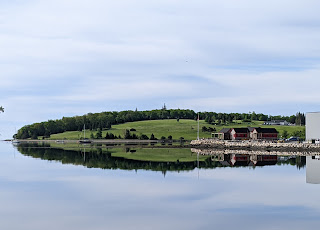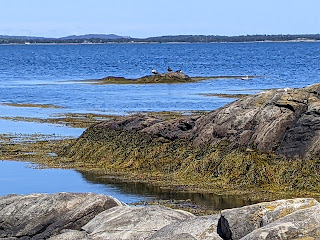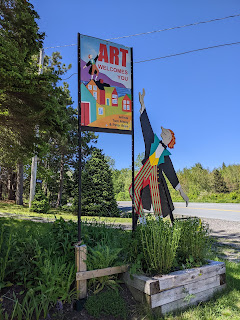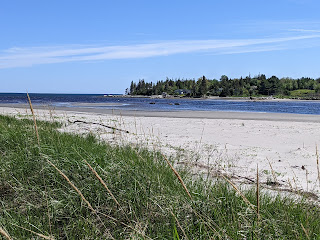Steven and I were so lucky to be invited to stay with our former Ottawa friends, Ellen and Peter, who had relocated to the small Nova Scotia town of Lunenburg on the province's South Shore years ago. Though we hadn't seen them since our children were young, Ellen and I had kept in touch. I think Covid gave me a wake-up call in the sense of wanting to reconnect with Canadian friends from years ago. That was now possible with the Canadian border having opened up to cross-border traffic for the first time in three years.
This Daily Travelogue is a labor of love for our families and friends at home and around the world. Prior to 2020, all our trips were documented on separate, yearly blogs which can be accessed below. Remember that clicking on any picture will open it for better viewing. Also, please consider adding your name at the end of any comments. Be safe, stay healthy, and stay connected.
Wednesday, August 10, 2022
6/2/22: Nova Scotia's Picture-Perfect Lighthouse Route!
When Ellen suggested the two of us go out for a walk and pick up some pastries at the local farmers' market, I was all in as I love to walk and pastries should be my middle name! I didn't realize that Ellen had really meant a 'brisk walk' with little dawdling and scant time for me to take pictures. Passersby would have had a tough time thinking we were walking together as I was constantly running to catch up with her!
I could see why Ellen and Peter had chosen Lunenburg as their new home apart from family living nearby as it was undoubtedly one of the most attractive towns in the province with so many homes painted in a "crayon box of primary colors." Its Old Town was designated a National Historic District in 1991 and just four years later the entire town received the ultimate honor when it was chosen as North America's second World Heritage Site by UNESCO. Canada's Quebec City also enjoys that coveted status.
Since Steven and I took our own walking tour of Lunenburg the following day, I won't delve now into the town's history.
I was rather surprised to see that Lunenburg's Farmers' Market took place in an ice arena and not in an open-air setting. Regardless of its unusual locale, it was a thriving place to be with produce, flowers, and baked goods to drool over!
After picking up some mouthwatering croissants and chocolate goodies, Ellen and I continued our walk in an effort to walk off all the calories we'd soon be consuming!
Lunenburg's 250th Anniversary Park was developed to celebrate the town's history and relationship with its harbor as well as to preserve access to the waterfront and green space for future generations. In 2005, the provincial government purchased a chunk of waterfront buildings and wharves to protect them from development.
Steven and I were thrilled that Ellen and Peter had again expressed their willingness to share their love of the area around Lunenburg with us. They began with a short drive west to East LaHave so we could take the ferry across LaHave River over to LaHave itself. I was surprised the Nova Scotia ferry system didn't charge a penny for the three cars and two bikes making the crossing. Peter said it used to cost a paltry .50 and just .25 with a coupon book!
This was the first time we'd traveled on a cable ferry and the first time seeing one since we were in Albania about ten years ago. The communities of East LaHave and LaHave have been linked by a cable ferry since 1832.
The crossing over the LaHave River was a scant five minutes long. In preparation for this post, I found out that people taking the ferry on January 3rd, 2014, weren't as lucky as we were as the cable broke free and the ferry drifted toward the open ocean!
Some of the homes we drove past in LaHave:
The Lighthouse Route was one of a half-dozen or so scenic routes that drivers can take around the province.
LaHave Outfitting was a combination crafts co-op, bookstore, and bakery that was a perfect one-place fits-all to while away some time after getting off the ferry.
Of course, I had to pick up a couple of tooth fairy pouches for our granddaughters, Max in San Francisco, and Clara in Chicago!
Darlene: I'm sure you'd have loved these small balls of local wool that had been dyed and carded. They would have been perfect for needle felting.
Suellen and Janina: Doesn't this look like the easiest and prettiest scarf pattern ever?!
Looking back on La Have:
A minute or two along the road was Fort Point, where we learned that LaHave Light Station had been built in 1875 to assist ships navigating the LaHave River. It lasted until the 1950s, when a new lighthouse keeper's home replaced the old station. A mechanical light on the opposite side of the river took over in the 1960s. At the end of that decade, Lunenburg County's Historical Society constructed a new building that was similar to the 1874 station. It also happened to be one of the first Canadian museums to use a geothermal system to cool and heat the museum, which also celebrates community events and artistic events throughout the year.
The small colony included a chapel and rooms for the Capuchin priests who also taught school. The settlement included stone storehouses for grain, munitions, and a well. Fruits, vegetables, and apple trees were planted. The trees on the property were descendants of those ancient trees.
It was a disgrace in my mind that only a small sign marked France's initial involvement in Canada. When French explorer Samuel de Champlain landed in LaHave, it was his first stop in North America before establishing a settlement further along the coast in Annapolis Royal.
From Fort Point, Peter drove us along the coast to the community of West Dublin, where three homes had been built with huge river rocks.
A little further along the coast was the two-kilometer-long Crescent Beach, the only one in the province that permitted people to drive on the beach as if it were a road! The barrier beach has been a roadway since European settlement in about 1785. At low tide, horses and wagons and later motorized vehicles drove over the packed sand. The less preferred dirt track behind the dunes had to be taken at high tide.
The speed limit on the beach:
Just a narrow strip of dunes separated the beach from the road.
A number of small uninhabited islands, called LaHave Islands, dotted the bay.
Bush Island was one of the twenty-plus LaHave Islands.
Marshes were a common sight on our journey.
Steven and I were glad that Ellen and Peter suggested we stop at the LaHave Islands Marine Museum for a bit. It was amazing to me that a community of just 50 souls could have supported a church of this size before it was converted into a museum.
The Methodist Church served the community from 1913-1925 before it became part of the United Church of Canada as a result of amalgamation. It was mainly a "marine access" church as the bridge from Bush Island to Bell Island wasn't constructed until the late 1970s. The museum purchased the building for the princely sum of $1 so it could display a large collection of local marine artifacts and information about inshore fishing and island life. The aim of the museum was to honor the fishermen and their families who were the backbone of the islands when fishing in LaHave Islands was at its prime.
It's no surprise that the Double Dory outside the museum was normally rowed or sailed by two people for fishing purposes! This one, however, was mainly towed by a motorboat and used to transport goods and sheep to West Ironbound Island.
You may recall my mentioning in the past how fantastically lucky Steven and I normally are when it comes to finding the last parking spot, driving hundreds of thousands of miles on highways, with road closures and back-ups occurring 95 percent of the time on the other side of the road, etc. That sort of luck was with us again when we arrived at the museum and discovered it had only opened for the season the day before.
Petite Riviere Community Park:
The small community of Green Bay was so, so pretty.
If you're a fan of simple white churches, as I have long been, look no further than any small town in Nova Scotia, as you will have your fill in no time!
We had only seen one re-created lighthouse on the Lighthouse Route and no restaurants or cafes to stop and get a bite to eat, so the four of us were thrilled to find this place with the welcoming chairs was actually serving food, as no sign beckoned travelers! Thankfully, the quiches and salads were delicious, not that we were too picky by then!
In the village of Petite Riviere, we stopped at the Maritime Painted Saltbox Fine Art Gallery, which was owned by two artists who had moved to Nova Scotia from Ontario in 1997. They opened their gallery in the barn, which had four showrooms on two levels.
Rissers Beach Provincial Park was a magical spot to walk along the boardwalk and view the area's inland marsh.
While Ellen and Peter relaxed on a bench, Steven and I walked to the end of the boardwalk and found a few people enjoying a lovely white sand beach.
I don't think our hosts missed us too much when we walked on ahead!
We arrived at the ferry with impeccable timing, getting on just moments before it took us back across the Lahave River to East LaHave. Was it ever confusing to have so many villages called LaHave in one permutation or another?!
The cable that connected both sides of the river:
I couldn't keep track of all the churches we saw that day - this one may have been in East LaHave, but I can't be sure!
St. Bartholomew's Anglican Church in Middle LaHave was founded in 1836 and was the oldest church along the LaHave River. It was deconsecrated in 2016.
Another picture-perfect church in another LaHave community, methinks!
Photos along the coast en route to Lunenburg:
Yeah, finally, our second lighthouse of the day on the Lighthouse Route, even though its roadside location wouldn't help any stranded mariners!
Lobster traps:
Peter mentioned oysters were sold at Faders Cove.
Late that afternoon, the four of us drank in the to-die-for views of the Lunenburg waterfront from a bar on the other side of the Lunenburg Harbor. It would have been awfully hard to make our time any better unless our other close friends, Rosine, Jean-Michel, Lezlie, and David, were also present. We four women hope we'll be able to meet up somewhere in this amazing world before too much more time passes.
Next post: Our guided tour of the South Shore continues!
Posted on August 10th, 2022, from Bentonville, in far northwest Arkansas, three months and some 11,000 miles since we left Denver on a marathon road trip. I think Steven and I are both a little despondent knowing our trip will be over in just a week, as this has been one helluva trip, thanks in huge part to our friends and family, whom we were lucky enough to visit in Canada. Don't feel too sad for us, however, as we've already booked flights and all accommodations for a seven-week trip to Central America beginning late next month!
Labels:
Nova Scotia
Subscribe to:
Post Comments (Atom)






























































































No comments:
Post a Comment